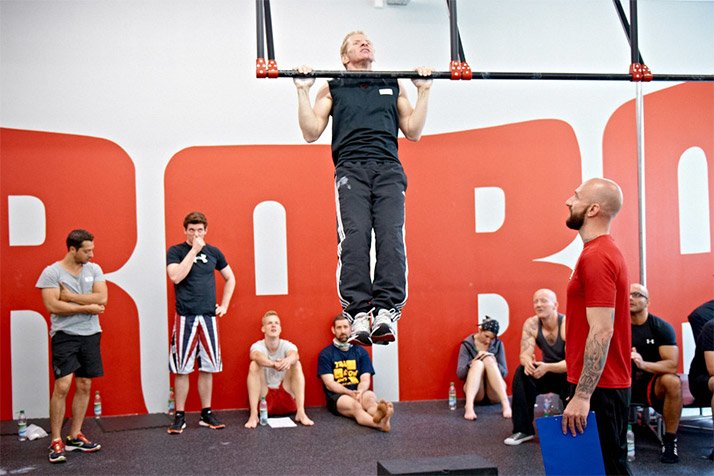
Build Serious Functional Strength With This 20 Pull-Up Plan
Feb 12, 2024Pull-ups are an excellent standard for strength, and being able to do 20 is a worthy challenge for anyone.
The truth is, you don't need to be huge to be strong. Sure, you can be both, but you don't have to be one to be the other.
Mastery of one's own body is the purest form of strength, in my opinion.
And remember, the lion is king of the jungle in spite of the fact that an elephant is ten times his size.
If you want to be a lion in the gym, you should start by mastering the pull-up.
It's the ultimate equalizer, putting the big boys on a level playing field with the smaller-framed, in a test of my favorite kind of strength: relative strength.
I don't care how much you can deadlift; if you can't do 20 strict pull-ups, you're not truly strong—yet.
But I can help you get there.
POUND-FOR-POUND STRENGTH

One of the great things about pull-ups is that they keep you honest.
If you're gaining weight and your reps on pull-ups are going down, you're getting fatter.
If your reps stay the same or go up, you're getting stronger.
It's that simple.
So stop kidding yourself that your 20-inch guns are pure muscle. Anyone who's 250 pounds of solid muscle should have no problem with the 20 pull-up challenge.
On the other hand, if you need a fat-loss goal that feels more satisfying than a number on the scale, this challenge is a good alternative.
FORM FIRST, REPS SECOND
Before you worry about getting to 20 reps, let's make sure you can do one proper pull-up.
Compared to other calisthenic staples like a handstand or pistol squat, both of which require a significant degree of neurological training, pull-ups are very simple to perform.
This is another reason why they are such a great standard for strength.
Just grab the bar tightly, keep your legs straight, and brace your entire body as you pull your chin over the bar.

It's important to get in the habit of doing clean reps from the start.
None of the 20 pull-ups that demonstrate your pound-for-pound prowess can involve the use of momentum.
Though you obviously have to lean back a bit to avoid hitting your head on the bar at the top, your torso shouldn't travel very far forward or backward.
Keep your body tight!
For this challenge, you can use the grip of your choice: overhand, underhand, or a neutral grip with palms facing each other...which some people may find more favorable to their joints.
As long as you come to a full extension at the bottom of every rep, and your chin goes above the bar without any uncertainty at the top of all 20 reps, you're good to go.
YOUR 20 PULL-UP PLAN
Once you've established solid pull-up technique, it's time to start adding up those reps.
I recommend setting a target number of pull-ups in each of your training sessions, then make it your goal to hit that number, no matter how many sets it takes, or how much rest you need between sets.
In order to determine the reps you should be aiming for in each workout, test yourself to find out your current max number of pull-ups in a single set without coming off the bar.
Then, use the chart below to determine the best way to progress.
| MAX PULL-UPS IN ONE SET | NUMBER TO AIM FOR IN ENTIRE WORKOUT |
|---|---|
| 1-3 reps | 10 per workout |
| 4-7 | 25 |
| 8-12 | 50 |
| 13-15 | 75 |
| 16-19 | 100 |
It's important to avoid sacrificing form in an attempt to complete more reps.
If 20 reps is your goal, quality will get you there faster—and feeling better—than sheer quantity.
This is why I encourage long breaks between sets.
DON'T SACRIFICE FORM IN AN ATTEMPT TO COMPLETE MORE REPS. QUALITY WILL GET YOU TO YOUR GOAL FASTER THAN QUANTITY.
Once you're able to complete the target number of reps, gradually begin working to reduce the amount of time and number of sets it takes to complete the reps over the course of the next several workouts.
When you can do your goal reps in less than 15 minutes total, including breaks, you can increase the total number of reps and begin the process again.
BE PATIENT AND RECOVER
Do this workout only once or twice a week at first, making sure you give yourself enough recovery time between training sessions.
You should be near 100 percent recovered from the last session before you do it again.
Even if you are doing this twice a week, you'll still want to hit the rest of your muscles with other exercises, but you probably won't need to do much else for your back and biceps.
IF YOU TRAIN PULL-UPS HARD, YOU WON'T NEED TO DO MUCH ELSE FOR YOUR BACK AND BICEPS.
Though progress will come slower or faster for different people depending on a number of factors, anyone who stays consistent over time will eventually start to see improvement.
After a couple of weeks, you can add in a third or even a fourth day, as long as you feel you are recovering quickly enough.

Then, when you feel ready, take a few days off and test yourself.
Keep your form strict, only grind as much as is absolutely necessary, and if it helps, have someone else do the counting.
When you feel your form slipping, stop—even if it's at 19 reps. Sure, you'll be disappointed, but comfort yourself with the knowledge that you're still doing wonders for your upper-body strength by adding these quality reps to your training.
Keep it up, then come back and try again!
Twenty pull-ups may not seem like very much in theory, but it's surprisingly rare to see them performed cleanly and with a full range of motion.
I hope you'll take this challenge seriously and not underestimate its difficulty.
It's time to raise the bar on your pull-up game!
Want to train one-on-one with the author? Try Online Personal Training.
Get articles like this every week!
Join our mailing list to receive weekly articles on strength, hypertrophy, and fitness from world-class coaches.
We hate SPAM. We will never sell your information, for any reason.





